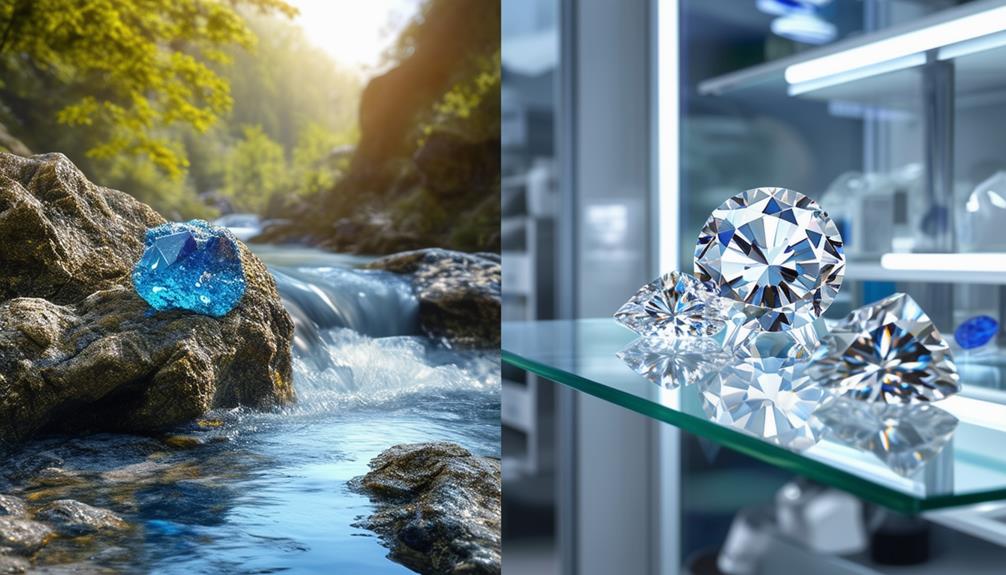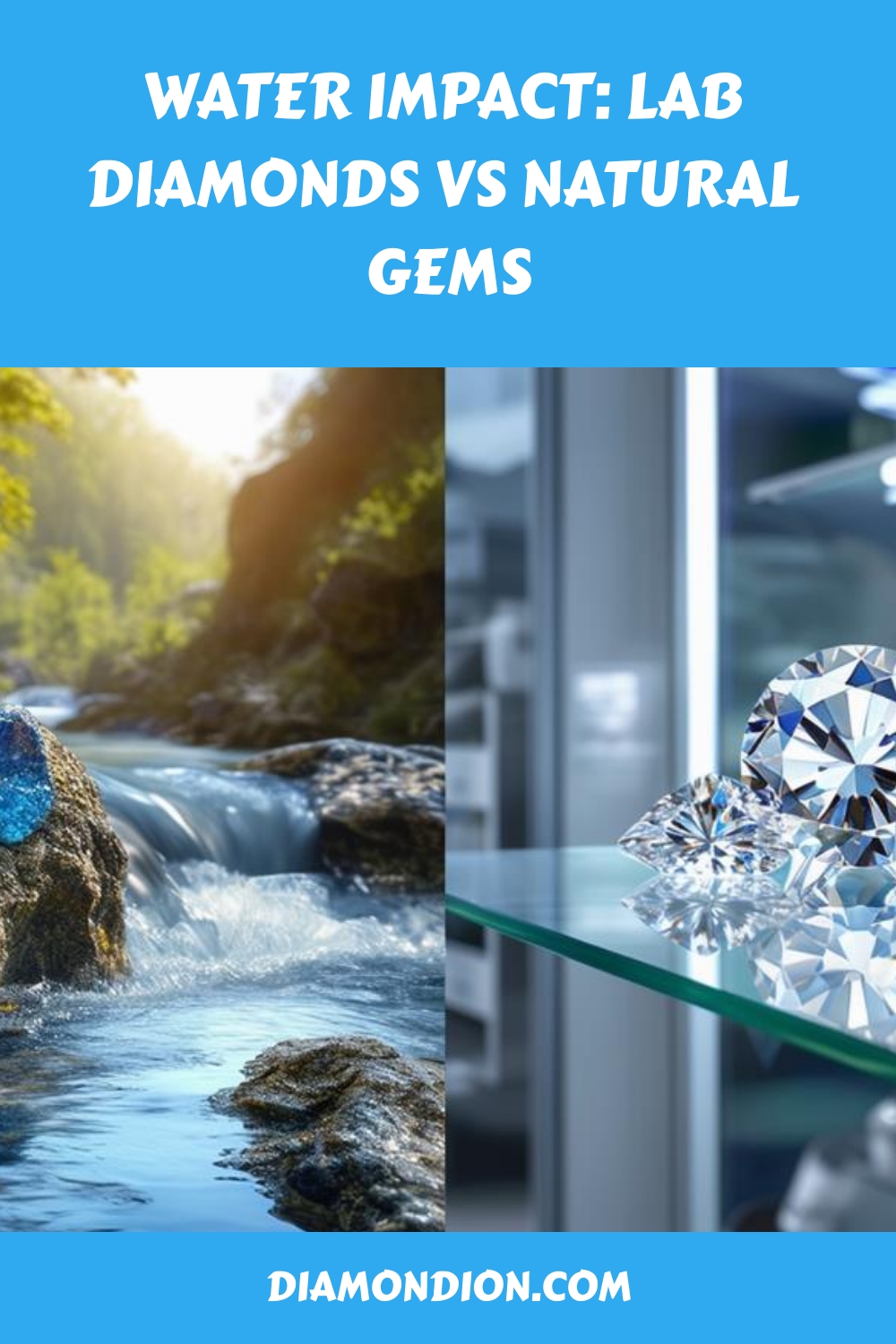Article Contents
Extracting natural diamonds requires an immense amount of water, using approximately 250 tons per carat, which has serious ecological consequences.
In contrast, lab-grown diamonds are significantly more sustainable, consuming up to 90% less water. Produced via methods such as Chemical Vapor Deposition (CVD) and High Pressure High Temperature (HPHT), these diamonds substantially reduce environmental impact.
Many lab diamond facilities employ advanced water recycling systems, which reuse much of the water, greatly aiding in water conservation.
Opting for lab-grown diamonds not only represents an ethical decision but also demonstrates a commitment to protecting the environment. Further exploration into this topic could offer more insights into the benefits of these sustainable alternatives.
Key Points
- Extracting natural diamonds requires up to 250 tons of water per carat, significantly depleting water resources.
- In contrast, lab-grown diamonds use approximately 90% less water than their natural counterparts, substantially reducing their environmental impact.
- Lab diamond facilities often employ closed-loop systems that recycle up to 90% of water used, enhancing water conservation efforts.
- Choosing lab-grown diamonds reduces the demand on freshwater resources, helping to preserve them.
- The production of lab diamonds supports sustainable water management practices and aids in protecting aquatic ecosystems from pollution.
Water Usage in Mining Diamonds
The process of extracting natural diamonds is highly water-intensive, with each carat requiring up to 250 tons of water. This contrasts sharply with the production of lab-grown diamonds, which use significantly less water. The extensive water use in mining natural diamonds not only highlights the environmental impact but also points to the pressing need for more sustainable practices in the industry.
Choosing lab-grown diamonds represents a shift towards less environmentally harmful methods. These diamonds, synthesised under controlled conditions, support water conservation and align with sustainable luxury practices. By opting for lab-grown diamonds, consumers can reduce the environmental burden, particularly concerning water use, and foster a more sustainable approach in the luxury goods sector.
This consumer choice promotes the conservation of natural resources and encourages the adoption of environmentally friendly practices within the diamond industry, contributing to a more responsible and sustainable approach to luxury. The preference for lab-grown diamonds thus supports ecological preservation while still offering the allure of fine jewellery.
Lab Diamond Production Process
When assessing the Lab Diamond Production Process, it's important to consider the sourcing of raw materials and the evaluation of energy usage. These elements are key in determining the environmental impact and sustainability of the lab-grown diamond industry.
Sourcing Raw Materials
The procurement of raw materials for creating lab-grown diamonds involves the selection of high-purity carbon sources like methane or graphite. This selection process is critical as it ensures the production of high-quality gemstones while adhering to ethical and sustainable practices.
By opting for controlled sources of carbon, manufacturers avoid the adverse environmental and social impacts associated with traditional diamond mining, such as ecological damage and human rights abuses. The meticulous choice of these carbon sources reflects a commitment to environmental conservation and ethical standards.
Consequently, lab-grown diamonds represent a responsible and progressive choice in the jewellery industry, appealing to consumers who value environmental and social responsibility.
Energy Consumption Analysis
Analysis of energy consumption for lab-grown diamonds indicates that creating one carat requires about 250 million joules. Compared to traditional mining of natural gems, this is considerably more energy-efficient and environmentally sustainable.
The process of lab diamond creation, especially through the chemical vapor deposition method, involves high pressure and temperature, demanding significant energy. Yet, it consumes far less than what is required for mining natural gems.
This efficiency not only supports environmental conservation but also reduces the ecological impact, fulfilling broader sustainability goals and fostering a responsible approach to luxury gem production.
Comparative Water Consumption
Lab-grown diamonds consume significantly less water compared to mined diamonds, using up to 90% less. This efficiency highlights their smaller environmental footprint, positioning them as a sustainable choice for environmentally conscious consumers. Traditional diamond mining, including open-pit methods, requires substantial water resources, which can deplete local supplies and cause ecological damage.
Techniques such as Chemical Vapor Deposition (CVD) and High Pressure High Temperature (HPHT) used in producing lab-grown diamonds are designed to minimise water usage. This not only helps conserve vital resources but also reduces the overall environmental harm from diamond production. The contrast in water consumption between lab-grown and mined diamonds clearly demonstrates the environmental benefits of the former.
Opting for lab-grown diamonds aids in water conservation and lessens ecological impact in mining areas. For consumers committed to making responsible and ethical purchasing decisions, lab-grown diamonds offer a viable and appealing alternative. This choice promotes the preservation of natural resources and supports sustainable practices in the luxury goods market.
Water Recycling Techniques
To promote sustainable luxury, the lab-grown diamond industry has adopted advanced water recycling methods, including closed-loop water systems. These systems ensure the water used during diamond production is continuously treated and reused, minimising reliance on new freshwater supplies.
Furthermore, these innovative purification techniques not only aid in environmental preservation but also increase the production process's efficiency and sustainability.
Closed-Loop Water Systems
Closed-loop water systems significantly enhance the sustainability of lab-grown diamond production by recycling up to 90% of the water utilised. These systems are crucial for water conservation and support sustainable practices in the industry. By implementing these systems, manufacturers demonstrate their commitment to environmental responsibility and efficient resource management.
Key benefits include:
- Reduction in Water Wastage: The majority of the water used in production is recycled and reused, minimising waste.
- Reduced Environmental Impact: These systems decrease the ecological footprint associated with manufacturing processes.
- Improved Resource Efficiency: They ensure sustainable water usage, crucial for conserving this scarce resource for future needs.
Closed-loop systems represent a critical advancement in promoting responsible industrial growth and long-term sustainability in diamond production.
Innovative Purification Methods
Advanced purification methods in lab-grown diamond facilities allow for the recycling and reuse of up to 90% of the water used during production. These systems focus on more than just conserving resources; they demonstrate a commitment to environmental sustainability. By integrating advanced filtration systems and purification technologies, these facilities ensure minimal water wastage and significantly reduce the ecological impact per carat of diamond produced.
| Feature | Benefit |
|---|---|
| Advanced Filtration | Ensures high-quality water for reuse |
| Purification Technology | Minimises contaminants, improving safety |
| Resource Conservation | Reduces water consumption, protects ecosystems |
| Sustainability Focus | Promotes long-term environmental health |
This strategy allows the industry to innovate while managing its environmental footprint responsibly.
Ecological Benefits of Lab Diamonds

Lab diamonds offer a sustainable option in the jewellery industry, significantly reducing water consumption and minimising environmental degradation. These synthetic gems are produced using advanced, sustainable manufacturing methods that conserve natural resources. Unlike traditional mining, which can deplete local water sources, lab diamond production employs technology that drastically cuts water use and reduces ecological impact.
The benefits of lab diamonds go beyond water conservation:
- Reduced Water Consumption: Lab-grown diamonds require far less water per carat than mined diamonds, demonstrating a commitment to environmental sustainability.
- Decreased Environmental Impact: The process of creating lab diamonds is controlled and generates minimal disruption to natural ecosystems, including aquatic environments.
- Promotion of Sustainability: Opting for lab-grown diamonds supports a consumption model that values ecological balance and aligns with the principles of those who champion environmental preservation and responsible resource use.
Water Impact on Ecosystems
The production of natural gems significantly impacts local ecosystems due to high water usage, which alters both terrestrial and aquatic environments. This intense water consumption not only affects the local biodiversity but also depletes water resources critical for the survival of various plant and animal species.
In contrast, the creation of lab-grown diamonds is a more sustainable option, utilising far less water, which helps preserve freshwater supplies and minimises ecological disruption. The production process in controlled environments ensures efficient water use and recycling, markedly reducing the environmental impact compared to traditional gem mining.
Furthermore, water pollution from natural gem mining poses severe risks to water quality and aquatic life, as runoff can introduce sediments and pollutants into waterways. Lab-grown diamonds mitigate these environmental threats by eliminating such pollution, thereby enhancing the preservation of aquatic ecosystems and contributing to more sustainable water management globally.
Future Water Conservation Strategies

Building on the sustainable methods of synthetic diamonds, future water conservation strategies will advance water efficiency and management in these production processes. Adopting cutting-edge technologies will be crucial in maintaining an eco-friendly approach to diamond creation.
To enhance water management, consider these steps:
- Implement Closed-loop Systems: Adopt advanced water recycling technologies within closed-loop systems to minimise water use and maximise efficiency.
- Enhance Rainwater Harvesting: By improving rainwater collection systems, facilities can reduce reliance on municipal water sources and increase their resilience to water scarcity.
- Invest in Ongoing Research: Continual research into innovative water conservation methods is vital. Supporting this research promotes ongoing advancements and maintains the industry's leadership in sustainable practices.
These strategies will help the synthetic diamond industry continue to exemplify how luxury and environmental responsibility can coexist. This dedication to sustainability not only benefits the industry but also serves as a model for environmental care.
Frequently Asked Questions
Do natural diamonds look better than lab-grown?
The aesthetic appeal of natural diamonds compared to lab-grown diamonds varies based on individual preferences and perceptions. Both types have unique qualities; however, the selection typically aligns with personal values and specific characteristics sought by the buyer.
What is the carbon footprint of lab-grown diamonds compared to natural diamonds?
Lab-grown diamonds typically emit around 6-10 kilograms of CO2 per carat, which is much lower than the 140 pounds (approximately 63 kilograms) of CO2 emitted per carat for natural diamonds that are mined. This variance is mainly because of the more energy-efficient production methods used for lab-grown diamonds in comparison to the extensive mining processes needed for natural diamonds.
Do natural diamonds sparkle more than lab-grown diamonds?
In terms of optical properties, both natural and lab-grown diamonds have similar refractive indices, resulting in comparable levels of brilliance and sparkle. Surveys show that over 80% of consumers cannot tell the difference between the two, highlighting that either choice does not sacrifice visual appeal.
Can you tell the difference between a natural and lab-grown diamond?
Identifying whether a diamond is natural or lab-created often requires sophisticated testing, as both types look almost identical to the naked eye. The price can vary significantly between the two, reflecting differences in origin that are important for informed consumer choices.
Conclusion
The process of extracting and marketing diamonds, whether mined from the earth or synthesised in laboratories, significantly affects vital water resources. Lab-grown diamonds, however, present a more sustainable option. They require less water and utilise advanced recycling methods.
At this critical juncture in environmental conservation, choosing lab-created diamonds could play a crucial role in protecting water ecosystems, ensuring the sustainability of our planet's essential water systems.



